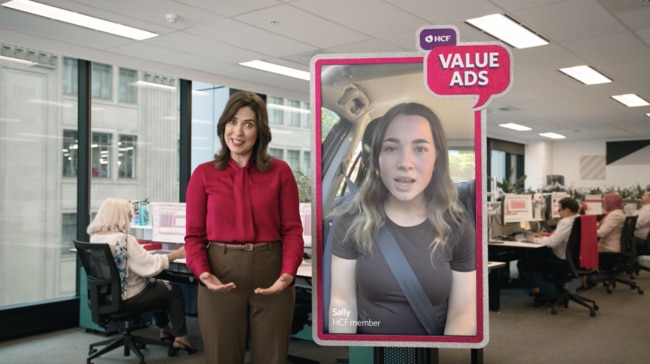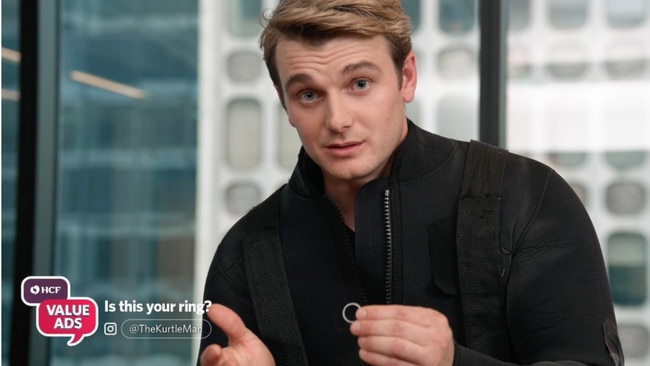HCF gives members the floor to push value message in new marketing campaign
In a category with low engagement, high churn and five big competitors, HCF is taking a creative approach to engage its members to help drive growth.

In the lead-up of the end of the financial year, the health fund category is awash with brands jostling to attract new customers. In a bid to cut-through this noise and showcase its commitment to its members, HCF has launched an initiative to provide its customers with more value.
The Value Ads initiative is giving HCF members the chance to take over the brand’s advertising and appear on TV, radio, social media, digital and even buses and shopping sites. The idea is that members can use the ads to do whatever they like – whether it’s wishing someone a happy birthday, kids showcasing their scooter skills or a pregnancy announcement. There are 6972 unique ad placements up for grabs for members.
HCF claims it’s all part of highlighting the value that the not-for-profit health fund offers to its members because it doesn’t have to answer to shareholders.
“We are the third largest health fund and the largest not-for-profit and when you look at our size in the market, compared to the others, we’re not going to behave like the bigger for-profit companies. The way that we behave is all about providing value for our members,” HCF marketing general manager Tatiana Papavero told The Growth Agenda.
“We looked at the other funds and how they were spending and behaving in the market and how consumers were feeling with the pressures of the cost of living. We knew that we needed to be creative and think about how to bring all the value in our programs to the forefront and we really needed to make sure that we were being smart in our tactics and our strategy to get the share of attention.”
The private health insurance market is a fiercely competitive battle ground with 55 per cent of the Australian population holding some form of health insurance, according to figures from the Australian Prudential Regulation Authority (APRA) from June last year.
Medibank and Bupa together boast more than half the market share with 27.5 per cent and 24.7 per cent share, respectively.
HCF comes in third with 12.4 per cent, followed by NIB with 9.4 per cent and HBF with 7.3 per cent, according to APRA’s 2023 figures.
The “big five” compete heavily with offer-led promotions and customer churn is high – although Ms Papavero claims HCF has one of the highest customer retention rates in the category – which presents challenges in creating brand differentiation and salience.
“It’s a complex category, there’s regulation and there’s many different nuances,” she said.
“We, and the industry in general, end up talking to consumers in these surface-level discussions, or go too much into doing the category job and explaining where you need or how you need to do it, which is really hard to differentiate.”

The Value Ads initiative is the second phase of the brand’s platform We Put Our Money Where Our Members Are, which was created by advertising agency Clemenger BBDO. HCF launched the platform in March and has seen a 31 per cent increase in brand salience in the period since.
“Salience is such a hard metric to move, which really showcases that the value and the not-for-profit ethos and how we behave and think is really resonating with consumers,” said Ms Papavero, who added that initial engagement and feedback to the current campaign had seen an increase in searches for HCF.
Building brand salience is particularly pertinent in the health insurance category, which consumers largely don’t think about until they need it, according to Clemenger BBDO national chief strategy and experience officer Simon Wassef.
“You don’t think about health insurance until something happens and you need it. But what we know about how our brains work is that we store things in our memory banks until such time when something happens and that’s when we think about the brands. That’s why, as a brand, you need to be telling people about who you are and why you are good so that you build that salience and are there in that memory bank.”
However, the biggest challenge, according to Mr Wassef, is changing the behaviours of Australian consumers towards health insurance. The high volume of churn which occurs at the end of the financial year has created an environment where consumers are conditioned to shop around for a better deal.
“That makes the imperative of investing in your brand even more important. There’s no point putting people in the top of the funnel if they are going to leak straight out next time around.
“So while you are always looking to fill the funnel in a unique and exciting way, once they are a member you need to provide the great value that keeps them there. That’s what these campaigns have tried to do.
“There are bigger players than HCF and they can talk louder so HCF have to be creative and shine through and really think about how to build a brand when its going to be out-shouted by others,” Mr Wassef said.
In the post-pandemic environment, there’s been a significant change in the way Australians value health insurance, particularly among Gen Z. In the years before the Covid-19 pandemic, the proportion of Australians with private health insurance had been in decline, according to APRA. However, this trend has reversed since 2020, with more people turning to health funds as part of an overall prioritisation of health.
Along with an overall growth in people taking out health policies, the major health funds have all reported increases in hospital cover policies for the under-30s category. APRA figures reveal that 54.6 per cent of Australians have extras cover and 44.9 per cent have hospital cover, however, most people have a combined policy.
The figures reflect an overall change in the way Australians value health with people increasingly seeking out information about the policies and researching their options to find the best deal for their individual needs. Both Ms Papavero and Mr Wassef noted that, despite the pressure of the increased cost-of-living, the majority of Australians maintain a view that health insurance is a necessity even as costs tighten. This refocus is why HCF has leaned into showcasing the value that it can offer members in its advertising, particularly as consumers spend more time assessing the different brands in market.
“One of the things we found fascinating in the research is the change in people’s behaviour. post-Covid,” Mr Wassef said. “We’ve seen traffic going away from the comparison sites with people now going directly to the brands to find out more. That big change in people’s behaviour means the brand has to show up everywhere, in the customer experience and the advertising.”






